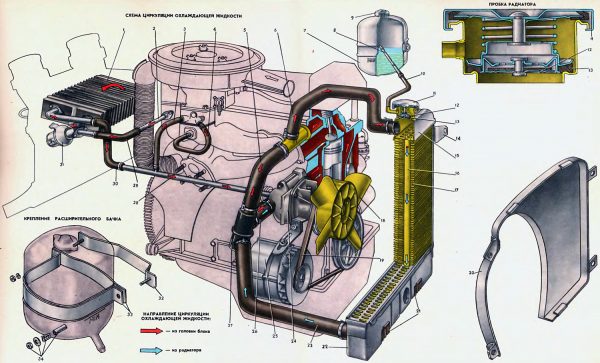
Cooling radiator VAZ-2101: operation and maintenance issues
Content
VAZ-2101 belongs to the family of "classic" models produced by the Volga Automobile Plant since 1970. The operation of the cooling system used in the "classic" is based on general principles, but each model has its own characteristics that should be considered during the operation and maintenance of the car. VAZ-2101 was the first-born of the family, so most of the technologies implemented here served as the foundation for their further development in subsequent generations of cars produced by the leader of the Soviet and Russian automotive industry. All this fully applies to the cooling system and its key node - the radiator. What should be taken into account by the owners of the VAZ-2101, who wanted this system on their car to work reliably and smoothly for a long time?
Cooling system VAZ-2101
The system used in the VAZ-2101 car is:
- liquid;
- closed type;
- with forced circulation.
The system holds 9,85 liters of antifreeze (together with heating) and consists of:
- radiator;
- pump;
- expansion tank;
- fan;
- hoses and branch pipes;
- cooling jackets of the head of the block and the block itself.
 VAZ-2101 vehicles use a closed-type liquid cooling system with forced circulation
VAZ-2101 vehicles use a closed-type liquid cooling system with forced circulation
The principle of operation of the cooling system is based on the fact that the liquid heated in the cooling jackets enters the radiator through pipes and hoses if its temperature exceeds a certain value. If the temperature of the coolant has not reached the specified limit, the thermostat blocks access to the radiator and circulation occurs in a small circle (bypassing the radiator). Then, with the help of a pump, the liquid is again sent to the cooling jackets. The interior heating system is connected to the circuit through which the liquid circulates. Using a thermostat allows you to quickly warm up the engine and maintain the required temperature of the running engine.
Cooling system radiator VAZ-2101
One of the most important elements of the cooling system is the radiator. Its main function is to remove excess heat from the liquid circulating in the engine cooling system. It should be remembered that overheating of the engine or its individual components can lead to the expansion of parts and, as a result, jamming of the pistons in the cylinders. In this case, a long and laborious repair will be required, so you should not ignore the first signs of a radiator malfunction.
The radiator is located in front of the hood, which allows a large amount of air to pass through it when driving. It is due to contact with air currents that the liquid is cooled. To increase the contact area, the radiator is made in the form of tubes and multilayer metal plates. In addition to the tubular-lamellar core, the radiator design includes upper and lower tanks (or boxes) equipped with necks, as well as a filler hole and a drain cock.
Parameters
The dimensions of the standard VAZ-2101 radiator are:
- length - 0,51 m;
- width - 0,39 m;
- height - 0,1 m.
The weight of the radiator is 7,19 kg, the material is copper, the design is two-row.
Among other features of the native “penny” radiator, we note the presence of a round hole in the lower tank, thanks to which the car can be started with a special handle - a “crooked starter”.
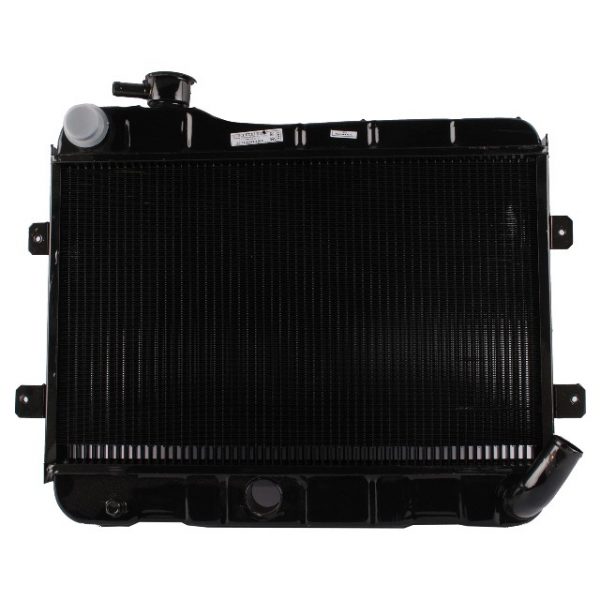
Alternative radiators for VAZ-2101
Often, in order to save money, VAZ-2101 owners install aluminum radiators instead of standard copper ones. However, there are other ways to replace. For example, a radiator from a VAZ-2106, 2103, 2105 or 2107 can be installed on a “penny”, although this may require changing the location of the mounting loops.
On the issue - brass is better in terms of heat dissipation - this is a matter of time of use. The fact is that the tubes are brass, and the “fins” are iron plates on them. And over time, these plates inevitably rust at the place of pressing into brass tubes and the thermal conductivity drops.
On the seven on a brass radiator (300 thousand km, 25 years old), I unsoldered the upper tank, cleaned the tubes with a brush, kept it filled with citric acid - I thought it would be cool as it should. Fuck there - as a result, I bought aluminum - a completely different matter. Now we need to fence aluminum for a penny, because it is cheaper new and all aluminum and does not rust.
Six radiator wider. He may not enter the archway. Normally suitable only native, penny. You can try to shove a triple. But the probability that the generator flywheel will touch the lower pipes is high. The tube from the triple radiator comes out at an obtuse angle. In a penny - under a straight line. Advice - it is better to take copper. Although more expensive, but more reliable, soldered, if anything, and aluminum for a penny is a rarity.
Video: replacing a VAZ 2101 radiator with a similar device from models 2104–07
Radiator repair
If the patency of the radiator has deteriorated or a leak has appeared, this does not mean that it needs to be replaced: first, you can remove the radiator and rinse the internal cavity or try to solder the cracks that have appeared. A leak, as a rule, becomes the result of excessive wear of the radiator. If the problem has appeared recently and the leak is insignificant, then the situation can be corrected with the help of special chemicals that are added to the antifreeze and after a certain time clog the cracks. However, such a measure, as a rule, is temporary, and if a crack appears, then sooner or later it will have to be soldered. Sometimes a small leak can be fixed with cold welding, a substance that resembles plasticine and hardens when applied to the surface of the radiator.
Most often, to eliminate leaks and clean the radiator, you have to dismantle it. In this case, you will need a screwdriver and open-end wrenches for 8 and 10. To remove the radiator, you must:
- Remove all hardware that obstructs access to the radiator.
- Drain the coolant from the system.
- Loosen the clamps and remove the upper hose from the radiator.

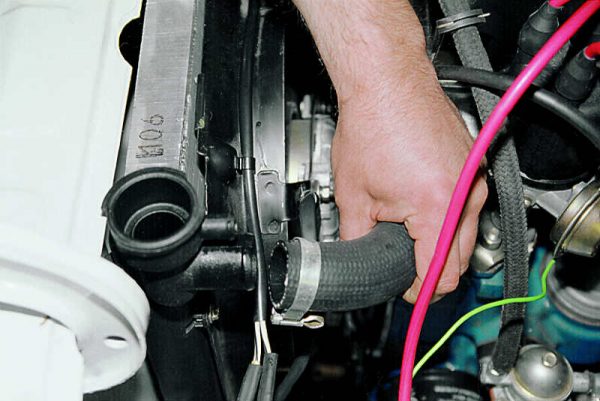 It is necessary to loosen the clamp and remove the upper hose from the radiator
It is necessary to loosen the clamp and remove the upper hose from the radiator - Remove the hose from the top radiator tank.

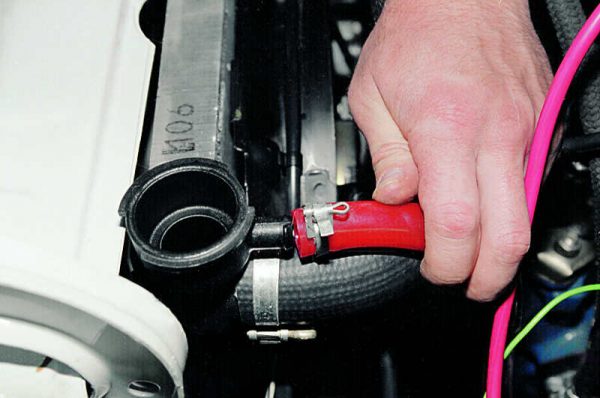 The hose of the upper tank is removed from the nozzle and laid aside
The hose of the upper tank is removed from the nozzle and laid aside - Remove the hose from the lower radiator tank.

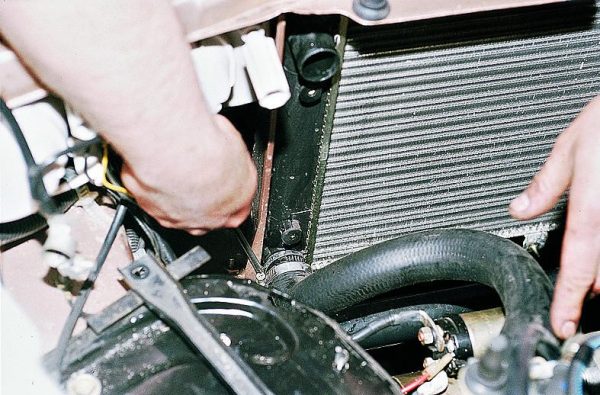 The hose from the lower branch pipe is removed in the same way
The hose from the lower branch pipe is removed in the same way - Disconnect the fan connector, which is located near the lower hose.
- Using an 8 wrench, unscrew the 3 bolts that secure the fan to the radiator and remove the fan.

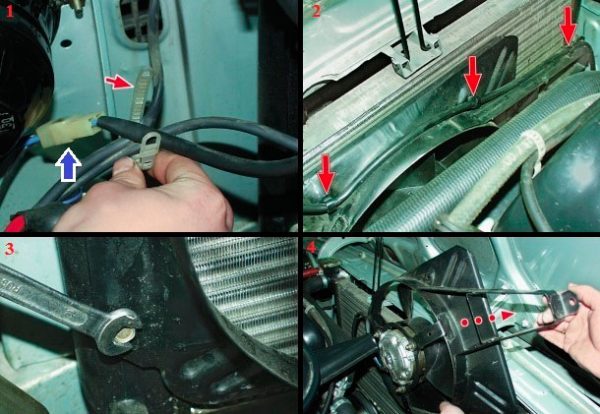 To remove the fan, unscrew the mounting bolts, remove the clamps holding the wiring, and pull out the casing
To remove the fan, unscrew the mounting bolts, remove the clamps holding the wiring, and pull out the casing - Using a 10 wrench, unscrew the 2 bolts that secure the radiator to the case.

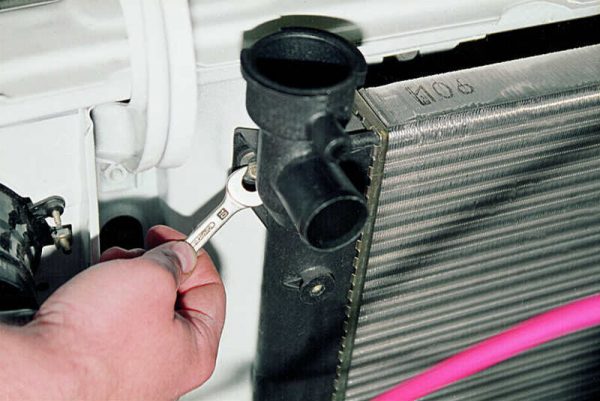 The radiator is attached to the body with two bolts, which are unscrewed with a 10 wrench.
The radiator is attached to the body with two bolts, which are unscrewed with a 10 wrench. - Remove the radiator from its seat.

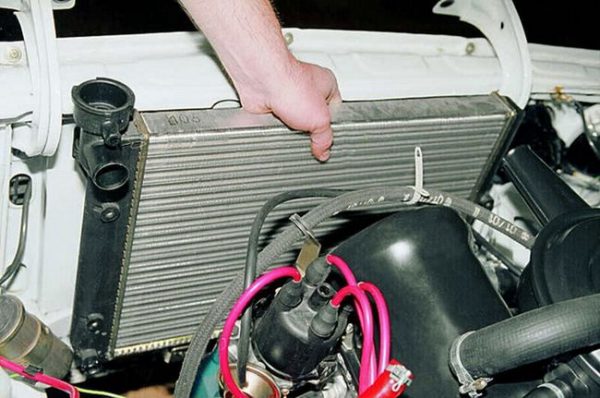 Having unscrewed the fixing bolts, it is necessary to remove the radiator from the seat
Having unscrewed the fixing bolts, it is necessary to remove the radiator from the seat - If it turns out that the radiator cushions have become unusable, replace them.

 If the radiator cushions have become unusable, they must be replaced.
If the radiator cushions have become unusable, they must be replaced.
To solder the radiator, it is necessary to determine the damaged area, carefully clean it with a metal brush, treat it with heated rosin and fill it with molten tin using a soldering iron.
Video: self-repair of the VAZ-2101 radiator


Watch this video on YouTube
Radiator fan
The cooling system works in such a way that the faster the engine crankshaft rotates, the more intense the pump drives fluid through the system. However, the engine heats up even at idle, when the car is stopped, so cooling is required in this case as well.. For this purpose, a special fan is provided, located in front of the radiator and driven to additionally cool the liquid.


Radiator activation sensor
In the very first VAZ-2101 models, the radiator switch-on sensor was not provided - such a device appeared closer to the removal of the "penny" from the conveyor. This sensor is designed to turn on the fan after the coolant temperature reaches a certain value, usually 95 degrees. The sensor is located at the bottom of the radiator in place of the drain hole.
If the fan stops turning on, you can check what is the reason by connecting the terminals coming to the sensor to each other. If the fan turns on, most likely the sensor needs to be replaced, if not, the reason may be in the fan motor or in the fuse.
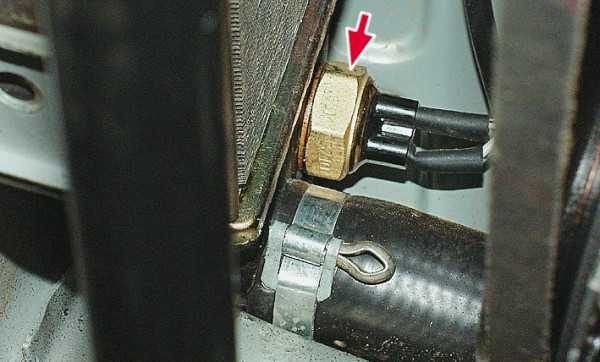

To replace the fan switch on sensor, it is necessary to disconnect the terminals and start unscrewing the sensor nut with a 30 wrench. Then unscrew it completely by hand and insert a new sensor in its place, the thread of which will be lubricated with sealant in advance. All this should be done as quickly as possible so that as little liquid as possible flows out of the radiator.
Replacing the coolant
A certain amount of water in antifreeze can cause corrosion of the radiator from the inside. In this regard, it is necessary to periodically flush the radiator so that its permeability does not decrease and the heat transfer properties do not deteriorate. To flush and clean the radiator, various chemicals are used that are poured into the tubes and remove scale and rust from the walls. In addition, it is necessary to carry out a complete replacement of the coolant after a certain mileage (as a rule, than every 40 thousand km).
When the thermostat is empty, the machine will warm up. Then it is necessary to drown out the small circle, otherwise the entire coolant goes through it, bypassing the radiator. It is most productive to drain all the old liquid, remove both the main radiator and the stove radiator and carry it home, rinse it inside and out in the bathroom. Inside, it is desirable to fill something like a fairy. There will be a lot of mud, he did this before winter. Then you put it all in place, fill in water with flushing for cooling systems, drive for 10 minutes, then drain, pour water, drive again and then fill in clean antifreeze.
In order not to get burned during operation, the coolant should be changed on a cold or warm engine. Replacement of antifreeze (or other coolant) is performed in the following sequence:
- The lever for controlling the supply of warm air to the passenger compartment is moved to the extreme right position. The heater tap in this case will be open.

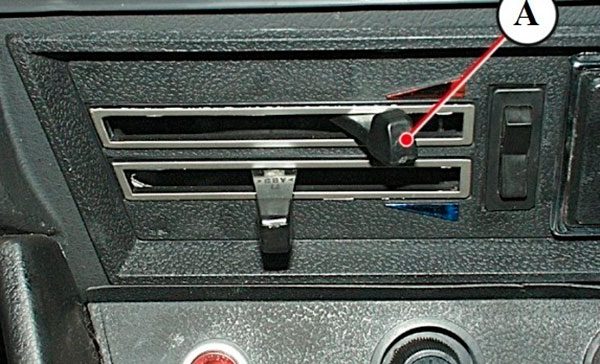 The lever for controlling the supply of warm air to the passenger compartment must be moved to the extreme right position
The lever for controlling the supply of warm air to the passenger compartment must be moved to the extreme right position - Unscrew and remove the radiator cap.

 Unscrew and remove the radiator cap
Unscrew and remove the radiator cap - The plug of the expansion tank is removed.

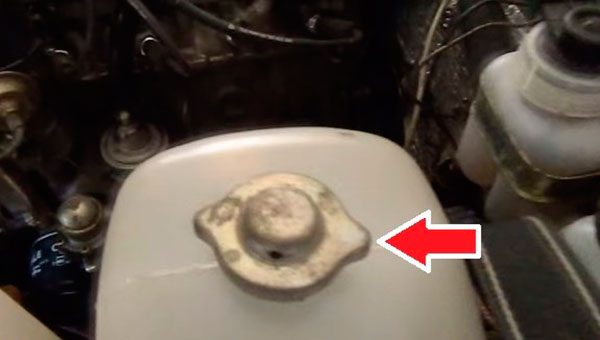 The plug of the expansion tank must be unscrewed and removed
The plug of the expansion tank must be unscrewed and removed - At the bottom of the radiator, the drain plug is unscrewed and the antifreeze is drained into a previously prepared container.

 When unscrewing the radiator drain plug, do not forget to substitute a container for taking antifreeze
When unscrewing the radiator drain plug, do not forget to substitute a container for taking antifreeze - In place of the plug, there may be a fan switch-on sensor, which must be unscrewed with a 30 key.

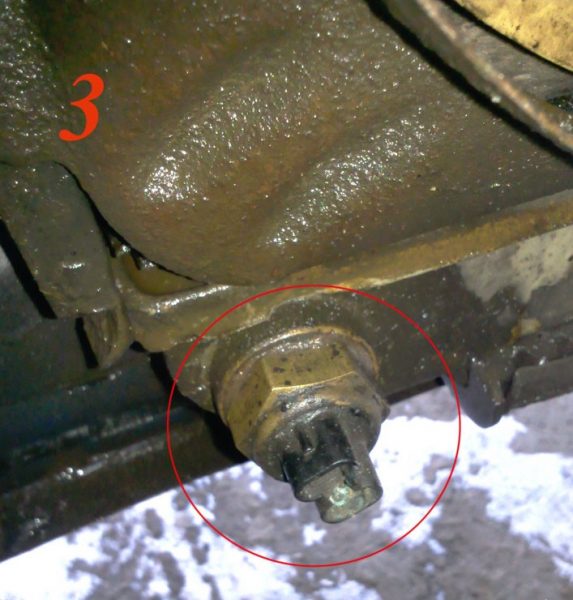 In the latest VAZ 2101 models, in place of the plug, there is a fan switch-on sensor
In the latest VAZ 2101 models, in place of the plug, there is a fan switch-on sensor - With a key of 13, the drain plug of the cylinder block is unscrewed and all the used liquid is drained into the substituted bottle.

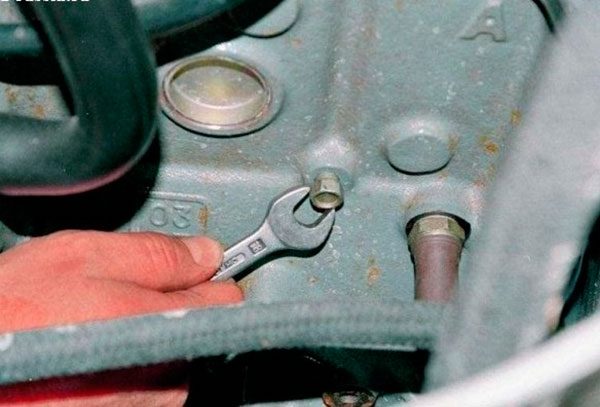 The drain plug of the cylinder block can be unscrewed with a key of 13
The drain plug of the cylinder block can be unscrewed with a key of 13
After the old antifreeze is removed from the system, it is necessary to replace the drain plugs of the radiator and cylinder block. New coolant is poured into the radiator and then into the expansion tank 3 mm above the min mark. To eliminate air locks, a hose is removed from the intake manifold fitting. As soon as liquid begins to flow from it, it is installed in place and tightly clamped with a clamp.


On this, the procedure for replacing antifreeze can be considered complete.
Video: self-replacement of coolant


Watch this video on YouTube
Radiator cover
The design of the cover (or plug) of the radiator allows you to completely isolate the cooling system from the external environment. The radiator cap is equipped with steam and air valves. The steam valve is pressed by a spring with an elasticity of 1250–2000 g. Due to this, the pressure in the radiator increases and the boiling point of the coolant rises to a value of 110–119 ° C. What does it give? First of all, the volume of liquid in the system decreases, i.e., the mass of the engine decreases, however, the required intensity of engine cooling is maintained.


The air valve is pressed by a spring with an elasticity of 50–100 g. It is designed to allow air to pass into the radiator if the liquid condenses after boiling and cooling. In other words, due to vaporization, excess pressure can form inside the radiator. In this case, the boiling point of the coolant rises, there is no dependence on atmospheric pressure, the discharge pressure is regulated by a valve in the plug. Thus, in the event of excessive pressure (0,5 kg / cm2 and above) in case of liquid boiling, the outlet valve opens and steam is discharged into the steam outlet pipe. If the pressure inside the radiator is below atmospheric, the intake valve allows air to enter the system.
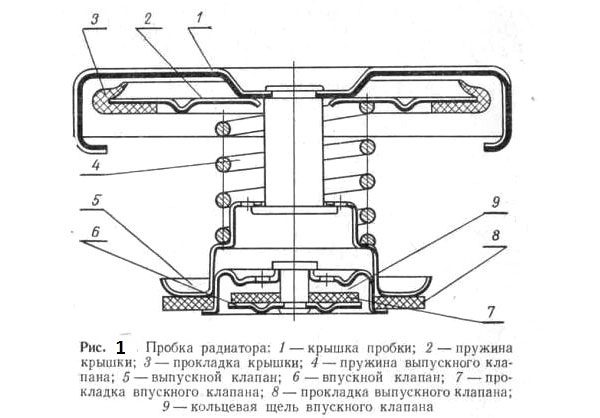

Without exaggeration, the cooling system radiator can be called one of the most important components of the entire power unit, since the serviceability and durability of the engine depend on its reliable operation. It is possible to extend the life of the VAZ-2101 radiator only through timely response to any signs of malfunction, regular maintenance, and the use of high-quality coolant. Despite the fact that the radiator can hardly be attributed to high-tech mechanisms, its role in the operation of the cooling system and the power unit as a whole continues to be key.

